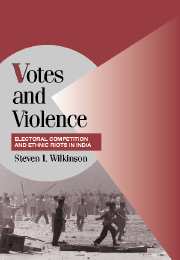Book contents
- Frontmatter
- Contents
- List of Figures
- List of Tables
- Acknowledgments
- 1 THE ELECTORAL INCENTIVES FOR ETHNIC VIOLENCE
- 2 EXPLAINING TOWN-LEVEL VARIATION IN HINDU-MUSLIM VIOLENCE
- 3 STATE CAPACITY EXPLANATIONS FOR HINDU-MUSLIM VIOLENCE
- 4 THE CONSOCIATIONAL EXPLANATION FOR HINDU-MUSLIM VIOLENCE
- 5 THE ELECTORAL INCENTIVES FOR HINDU-MUSLIM VIOLENCE
- 6 PARTY COMPETITION AND HINDU-MUSLIM VIOLENCE
- 7 THE ELECTORAL INCENTIVES FOR ETHNIC VIOLENCE IN COMPARATIVE PERSPECTIVE
- 8 DEMOCRACY AND ETHNIC VIOLENCE
- Appendix A Data Sources for Hindu-Muslim Riots
- Appendix B Data-Entering Protocol for Riot Database
- Appendix C Additional Results from Statistical Tables
- References
- Index
- Cambridge Studies in Comparative Politics
7 - THE ELECTORAL INCENTIVES FOR ETHNIC VIOLENCE IN COMPARATIVE PERSPECTIVE
Published online by Cambridge University Press: 28 July 2009
- Frontmatter
- Contents
- List of Figures
- List of Tables
- Acknowledgments
- 1 THE ELECTORAL INCENTIVES FOR ETHNIC VIOLENCE
- 2 EXPLAINING TOWN-LEVEL VARIATION IN HINDU-MUSLIM VIOLENCE
- 3 STATE CAPACITY EXPLANATIONS FOR HINDU-MUSLIM VIOLENCE
- 4 THE CONSOCIATIONAL EXPLANATION FOR HINDU-MUSLIM VIOLENCE
- 5 THE ELECTORAL INCENTIVES FOR HINDU-MUSLIM VIOLENCE
- 6 PARTY COMPETITION AND HINDU-MUSLIM VIOLENCE
- 7 THE ELECTORAL INCENTIVES FOR ETHNIC VIOLENCE IN COMPARATIVE PERSPECTIVE
- 8 DEMOCRACY AND ETHNIC VIOLENCE
- Appendix A Data Sources for Hindu-Muslim Riots
- Appendix B Data-Entering Protocol for Riot Database
- Appendix C Additional Results from Statistical Tables
- References
- Index
- Cambridge Studies in Comparative Politics
Summary
A full comparative test of the electoral explanation I have developed for explaining violence in India in the preceding chapters would require a blend of large-N research and case studies, together with detailed information on electoral competition, polarizing events, and ethnic violence in many countries since the 19th century. My goals in this chapter are more limited. My aim is to identify multiethnic states where we would expect increased political competition to lead to an increase in local ethnic polarization and then to examine how the level of government in charge of the police or army responds to this polarization and the threat of violence. When electoral competition increases in an ethnically divided society, do local politicians in close seats respond by organizing demonstrations and polarizing events in order to attract swing voters? If violence results from these mobilizations, how does the state respond? Does the state response depend as in India on the level of effective party competition in the state and on whether the state relies on the votes of the group doing the attacking or those being attacked?
I examine three cases where multiethnic societies moved from uncompetitive party systems to competitive systems in a relatively short space of time: 19th-century Ireland, postindependence Malaysia, and post-Communist Romania.
- Type
- Chapter
- Information
- Votes and ViolenceElectoral Competition and Ethnic Riots in India, pp. 204 - 235Publisher: Cambridge University PressPrint publication year: 2004

